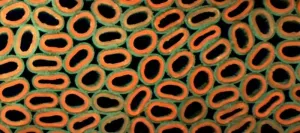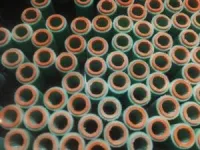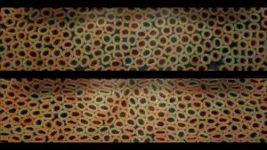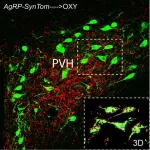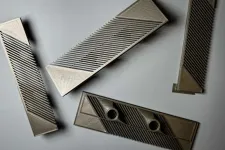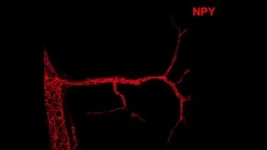(Press-News.org) Researchers Samuel Poincloux (currently at Aoyama Gakuin University) and Kazumasa A. Takeuchi of the University of Tokyo have clarified the conditions under which large numbers of “squishy” grains, which can change their shape in response to external forces, transition from acting like a solid to acting like a liquid. Similar transitions occur in many biological processes, including the development of an embryo: cells are “squishy” biological “grains” that form solid tissues and sometimes flow to form different organs. Thus, the experimental and theoretical framework elaborated here will help separate the roles of mechanical and biochemical processes, a critical challenge in biology. The findings were published in the journal Proceedings of the National Academy of Sciences (PNAS).
Imagine a pile of sand on a table. As we slowly raise one end of the table, it first sits undisturbed and acts like a solid. However, at a critical angle, the forces keeping the sandpile together yield to gravity: the pile breaks down and starts flowing, acting like a liquid. This is a yielding transition, a widely studied phenomenon with “grains” that do not change shape, such as sand or rocks. However, “grains” in biology are often “squishy,” adapting their shape to external forces.
“Although our research revisits a well-studied problem,” says Poincloux, the first author, “it hits the sweet spot of being complicated enough to be interesting and simple enough to develop various approaches. We incorporated interdisciplinary components, such as using a biomechanical tool that helped differentiate if the “grains” were changing shapes or positions.”
Indeed, the researchers approached the challenge through experiments, computer modeling, and geometrical description. They used slender rubber rings as their “squishy” grains and stacked them in a container. They varied the number of rings, the density of “grains,” and the strength of lateral forces applied to the rings. Then, using pictures, the researchers measured the rings’ positions, shapes, and points of contact with each other as the batch of rings deformed. These measures allowed them to quantify how much the rings changed position (liquid-like behavior) or shape (solid-like behavior). Lastly, they performed computer simulations and geometric analyses to understand the role of friction and interactions between rings.
“We found the main surprise at the very end of the project,” says Poincloux. “Surprisingly, a simple geometrical description underlies the yielding transition observed, despite involving large and complex shape changes coupled with frictional interactions.”
These findings are the first steps toward understanding how “squishy” biological grains interact in living organisms, and Poincloux is already thinking of what to do next.
“To get closer to biological tissues, we could, for instance, modify the interactions and add ring adhesion to emulate linking proteins between cells. For those intending to use these squishy rings for experiments: do not forget to put a cover lid on top of the container to prevent the explosion of hundreds of rings across the laboratory… I will not disclose the number of times this incident happened.”
END
Researchers uncover what makes large numbers of “squishy” grains start flowing
Such rigidity transitions, from solid-like to fluid-like behavior, are widespread and crucial for biological tissue mechanics
2024-11-25
ELSE PRESS RELEASES FROM THIS DATE:
Scientists uncover new mechanism in bacterial DNA enzyme opening pathways for antibiotic development
2024-11-25
Researchers from Durham University, Jagiellonian University (Poland) and the John Innes Centre have achieved a breakthrough in understanding DNA gyrase, a vital bacterial enzyme and key antibiotic target.
This enzyme, present in bacteria but absent in humans, plays a crucial role in supercoiling DNA, a necessary process for bacterial survival.
Using high-resolution cryo-electron microscopy the researchers reveal unprecedented detail of gyrase’s action on DNA, potentially opening doors for new antibiotic therapies against resistant bacteria.
The research is published in Proceedings of the ...
New study reveals the explosive secret of the squirting cucumber
2024-11-25
UNDER EMBARGO UNTIL 20:00 GMT / 15:00 ET MONDAY 25 NOVEMBER 2024
New study reveals the explosive secret of the squirting cucumber
IMAGES AND VIDEO AVAILABLE – SEE NOTES SECTION BELOW
A team led by the University of Oxford has solved a mystery that has intrigued scientists for centuries: how does the squirting cucumber squirt? The findings, achieved through a combination of experiments, high-speed videography, image analysis, and advanced mathematical modelling, have been published today (25 November) in The Proceedings of the National Academy of Sciences (PNAS).
The squirting cucumber (Ecballium elaterium, from the Greek ‘ekballein,’ meaning to throw out) is named for ...
Vanderbilt authors find evidence that the hunger hormone leptin can direct neural development in a leptin receptor–independent manner
2024-11-25
Researchers from the Vanderbilt University School of Medicine Basic Sciences have uncovered the first example of activity-dependent development of hypothalamic neural circuitry. Although previous research has shown that the hormone leptin acts directly on hunger neurons through leptin receptors to promote the development of neural circuitry, results that will be published in PNAS on Nov. 25 indicate that certain neurons that do not express leptin receptors are nonetheless sensitive to its activity.
The research, led by the lab of Richard Simerly, Louise B. McGavock Professor and professor of molecular physiology ...
To design better water filters, MIT engineers look to manta rays
2024-11-25
Filter feeders are everywhere in the animal world, from tiny crustaceans and certain types of coral and krill, to various molluscs, barnacles, and even massive basking sharks and baleen whales. Now, MIT engineers have found that one filter feeder has evolved to sift food in ways that could improve the design of industrial water filters.
In a paper appearing this week in the Proceedings of the National Academy of Sciences, the team characterizes the filter-feeding mechanism of the mobula ray — a family of ...
Self-assembling proteins can be used for higher performance, more sustainable skincare products
2024-11-25
If you have a meticulous skincare routine, you know that personal skincare products (PSCPs) are a big business. The PSCP industry will reach $74.12 billion USD by 2027, with an annual growth rate of 8.64%. With such competition, companies are always looking to engineer themselves an edge, producing products that perform better without the downsides of current offerings.
In a new study published in ACS Applied Polymer Materials from the lab of Professor of Chemical and Biomolecular Engineering Jin Kim Montclare, researchers have created a novel protein-based gel as a potential ingredient in sustainable and high-performance PSCPs. This protein-based ...
Cannabis, maybe, for attention problems
2024-11-25
Cannabis — whether marijuana itself or various products containing cannabinoids and/or THC, the main psychoactive compound in weed – have been touted as panaceas for everything from anxiety and sleep problems to epilepsy and cancer pain.
Nursing researcher Jennie Ryan, PhD, at Thomas Jefferson University, studies the effects of cannabis on symptoms of attention deficit hyperactivity disorder (ADHD). Current medical guidelines for ADHD include medications such as Adderall and cognitive behavioral therapy. ...
Building a better path to recovery for OUD
2024-11-25
A new study led by Thomas Jefferson University researchers highlights critical healthcare gaps that hinder long-term recovery for people living with opioid use disorders (OUD) in Philadelphia.
The researchers conducted 13 focus groups with 70 participants accessing various types of OUD treatment. Participants reported several challenges, such as lengthy and restrictive assessment processes, inadequate operating hours and lack of sufficient withdrawal management. Participants also reported broader socio-economic needs, such as housing and income support, as barriers to their recovery.
Meghan Reed, PhD, MPH, senior ...
How climate change threatens this iconic Florida bird
2024-11-25
ITHACA, N.Y. – Because of warmer winters, Florida scrub-jays are now nesting one week earlier than they did in 1981. But these early birds are not always getting the worm.
A new analysis of data from a long-term study, published in Ornithological Advances, finds that warmer winters driven by climate change reduced the number of offspring raised annually by the federally threatened Florida scrub-jay by 25% since 1981.
Warmer temperatures, the scientists hypothesize, make jay nests susceptible to predation by snakes for a longer period of the Florida ...
Study reveals new factor involved in controlling calorie expenditure
2024-11-25
An international team of researchers has discovered a new component of the peripheral nervous system that acts by increasing energy metabolism in the body. The finding paves the way for the development of simpler and cheaper drugs to control obesity and weight gain, regardless of the amount of food ingested.
In an article published in the journal Nature, researchers from the University of Oxford in the United Kingdom and the Obesity and Comorbidities Research Center (OCRC) – funded by FAPESP and based at the State University of Campinas (UNICAMP) in Brazil – describe where and how this component ...
Managing forests with smart technologies
2024-11-25
Deforestation has remained a significant issue globally, with primary forests contributing to 16 per cent of the total tree cover loss in the last two decades, driven by climate change and intensive human activity. This threatens natural resources, biodiversity, and people’s quality of life. To protect forests, Lithuanian scientists, in collaboration with Swedish experts, have developed Forest 4.0, an intelligent forest data processing model integrating blockchain, Internet of Things (IoT), and Artificial Intelligence (AI) technologies. The system ...
LAST 30 PRESS RELEASES:
For teens, any cannabis use may have impact on emotional health, academic performance
School meals could unlock major gains for human and planetary health
Menopause hormone therapy does not appear to impact dementia risk
Signature patterns of brain activity may help predict recovery from traumatic brain injury
Dresden study uncovers new key mechanism in cancer cells
New species are now being discovered faster than ever before, study suggests
Cannabis-based products show limited short-term benefit for chronic pain, with increased risk of adverse effects
Cannabis products with more THC slightly reduce pain but cause more side effects
Clearing the brain of aging cells could aid epilepsy and reduce seizures
Brain injuries linked with potential risk of suicide, new study finds
New technique lights up where drugs go in the body, cell by cell
New study finds movement of fishing fleets can reveal shifts in marine ecosystems
Embargoed: New evidence points to potential treatment for vascular dementia
Study uncovers disrupted brain balance in alcohol dependence
Working in groups can help Republicans and Democrats agree on controversial content moderation online
Structural findings reveal how distinct GPCR ligands create different levels of activation
Anything-goes “anyons” may be at the root of surprising quantum experiments
UC review: Maximizing workplace opportunity for veterans
From generation to complex control: Metasurfaces make perfect vortex beams "within reach"
Thin-film lithium niobate-based detector: recent advances and perspectives
Exploring why some people may tend to persistently make bad choices
How cells balance their protein levels
Nirsevimab vs RSVpreF vaccine for RSV–related hospitalization in newborns
Effectiveness and impact of maternal RSV immunization and nirsevimab on medically attended RSV in US children
AI gives scientists a boost, but at the cost of too many mediocre papers
Next-generation vision model maps tree growth at sub-meter precision
Genes aren’t destiny for inherited blindness, study shows
MIT study: High-fat diets make liver cells more likely to become cancerous
Exposure to multiple fine particulate matter components and incident depression in the US Medicare population
Risk of burdensome health care spending over time in the US
[Press-News.org] Researchers uncover what makes large numbers of “squishy” grains start flowingSuch rigidity transitions, from solid-like to fluid-like behavior, are widespread and crucial for biological tissue mechanics
